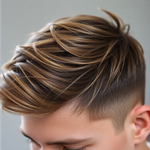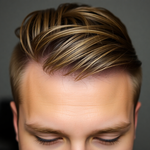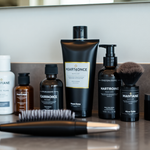
Color Confidence: How Semi-Permanent Hair Dye Streamlines a Sustainable Men's Capsule Wardrobe
17 August 2025
Share
Introduction
Struggling to look intentional without buying a closet full of stuff? Semi-permanent hair dye can be the quick, reversible styling move that ties your whole look together. In a capsule wardrobe, where every piece must earn its place, a simple hair tone adjustment can increase outfit combinations, reduce impulse purchases, and boost confidence—fast. Read on for a full playbook that blends style, sustainability, and practical grooming for men aged 18–45.
Semi-Permanent Hair Dye: Why It Works for a Capsule Wardrobe
Semi-permanent hair dye is a perfect match for capsule thinking: low-commitment, low-maintenance, and high-impact. Unlike permanent color, semi-permanent options deposit color without fully penetrating the hair cortex, which means gentler chemistry, fewer harsh touch-ups, and an easier route back to your natural shade. For men who want to streamline their wardrobe and lifestyle, that translates to fewer salon visits, less product waste, and more stylistic agility.
How color coherence cuts wardrobe clutter
Your tube of semi-permanent dye does more than change strands—it harmonizes your visual palette. When hair tone, skin undertone, and clothing colors align, the brain perceives a more curated, higher-end look. That perception lets you own fewer pieces but still look polished. Practical outcomes:
- Every shirt and jacket plays nicer together, increasing outfit permutations.
- Neutral staples (navy, gray, olive) read cleaner against complementary hair tones.
- Secondhand or sustainably made items look intentional rather than mismatched.
Real benefits: confidence, cost savings, and sustainability
Here’s what you actually get when you add semi-permanent hair dye into a capsule strategy:
- Confidence fast: A subtle color change can sharpen facial features and improve how clothes sit visually—useful before dates, interviews, or events.
- Lower lifetime cost: Fewer bad buys because your existing pieces work better together; fewer salon sessions compared with permanent dye.
- Smaller environmental footprint: Semi-permanent formulas often require less processing and fewer chemical byproducts over time; plus, you reduce consumption by buying fewer garments.
Choosing the right shade for maximum versatility
Not all colors help your capsule. Pick shades that amplify, not compete with, your wardrobe.
- Cool-leaning wardrobes (blues, grays): Opt for ash brown or neutral dark tones to enhance contrast without clashing.
- Warm-leaning wardrobes (olive, tan, rust): Warm chestnut or rich dark brown adds harmony and a healthy glow.
- Minimalist black/white-focused wardrobes: A deep, natural black or soft brown keeps the look sharp without stealing focus.
Step-by-step system: Integrating semi-permanent dye into your capsule routine
Follow this practical six-step system to experiment safely and get predictable results.
- Audit your closet: Lay out your 10 most-worn pieces and note undertones (cool vs. warm). This pins the hair family you should aim for.
- Pick a target shade: Choose a shade within one or two levels of your natural color. Semi-permanent hair dye works best when it enhances rather than dramatically changes your base tone.
- Patch and strand test: Always do a skin patch test and a strand test in natural light to preview outcomes and rule out allergies.
- Decide DIY vs. pro: Home kits are cost-effective; a single pro consult can help dial the undertone. If you're keeping it natural, a kit usually suffices.
- Implement color-friendly care: Use color-safe shampoo, wash with cool water, and space washes with dry shampoo to extend color life and save water.
- Rotate and reassess: Reevaluate every 8–12 weeks. Semi-permanent fades are forgiving—use that window to test seasonal tweaks without long-term commitment.
Maintenance schedule and product tips
Keep the change looking deliberate with low-effort habits that also respect the planet:
- Wash 2–3 times weekly at most; use a sulfate-free, color-safe shampoo and a concentrated conditioner.
- Rinse with cooler water to slow fade and reduce energy use.
- Use dry shampoo to freshen between washes and extend product life.
- Choose ammonia-free, cruelty-free, or plant-forward semi-permanent formulas when possible, and recycle packaging where facilities exist.
At-home vs. salon: what to consider
Both paths are valid. Consider these trade-offs before you commit:
- At-home kits: Cheaper, convenient, and ideal for subtle, single-tone updates. Best if you have a basic understanding of undertones.
- Salon visits: Useful for multi-dimensional color, textured cuts, or if you’re shifting several shades. A salon can also provide a tailored color formula and professional-grade color-safe products.
Case examples: Wardrobe archetypes and color pairings
Here are concrete pairings for common men's capsule archetypes so you can visualize how hair color transforms outfits.
- Young professional (navy, gray, crisp whites): Ash brown or neutral dark hair enhances contrast and looks polished with sharp tailoring.
- Creative/urban (bold textures, layered neutrals): Subtle highlights or lowlights add depth and personality without clashing with patterns.
- Outdoorsy/minimal (earth tones, rugged fabrics): Warm chestnut or soft brown brings out warmth in olive and tan palettes.
Color safety and ingredient awareness
Not all dyes are created equal. Look for transparent ingredient lists and avoid dyes with high levels of persulfates or harsh ammonia when possible. If you have sensitive skin, a dermatology consult before color treatments is a smart move—WebMD has a good primer on hair dye safety and reactions (WebMD: hair dye safety basics).
Stretching sustainability: lifecycle thinking for hair and clothing
Integrating semi-permanent hair dye into a sustainable lifestyle is about lifecycle choices. A longer-lasting, well-coordinated wardrobe cuts textile waste; gentler hair color choices cut chemical and water impacts over time. Practical sustainability actions:
- Buy fewer, higher-quality garments that pair easily with your chosen hair tone.
- Choose concentrated, refillable grooming products and recycle packaging.
- Limit salon travel by choosing semi-permanent options that need less frequent maintenance.
DIY color plan: a 90-day experiment
Want to test without long-term risk? Follow this 90-day plan:
- Week 1: Audit wardrobe and choose a shade. Strand test and patch test.
- Week 2: Apply at home or visit a salon for initial color. Document looks with photos under natural light.
- Weeks 3–8: Follow color care routine, rotate key outfits to see compatibility, note which pieces feel redundant.
- Weeks 9–12: Reassess. If the color works, consider replacing one or two garments with higher-quality sustainable alternatives that match your new palette.
FAQs
- Will semi-permanent color damage my hair? Generally less than permanent dyes because they require less aggressive chemistry. Use conditioning treatments to keep hair healthy.
- How long does semi-permanent color last? Usually 4–8 weeks depending on wash frequency and product quality.
- Can I switch tones seasonally? Yes—semi-permanent dyes are ideal for seasonal tweaks (warmer in fall, cooler in spring) without long-term commitment.
Before-and-after scenarios: practical wins
Mate, here are two quick real-world wins I’ve seen:
- Career pivot: A 29-year-old shifted to a cooler ash tone before a client-facing promotion. Same navy blazer, same shirts—he appeared more put-together and confident, cutting down micro-adjustments before meetings.
- Wardrobe refresh: A 35-year-old with an earth-toned capsule used warm chestnut dye to harmonize secondhand finds. He reported fewer impulse buys and more outfit flexibility.
Where Menll.com can help
For staples that play well with a streamlined color story, check Menll.com’s outerwear collection for neutral jackets that work year-round: Menll.com outerwear collection. If you’re updating grooming alongside color, Menll.com’s grooming guide offers practical tips on care and product choices: Menll.com grooming guide. Menll.com’s EcoSneak Casual Shoes are also a solid, eco-conscious finish for most capsule looks.
Final checklist: implement color confidence today
Use this checklist to take action this week:
- Audit your top 10 garments and note undertones.
- Choose a semi-permanent shade within 1–2 levels of your natural color.
- Do a patch and strand test.
- Decide DIY or pro based on complexity; buy a color-safe shampoo.
- Document looks and reassess after 8–12 weeks.
Closing thoughts
Small moves can lead to big style returns. Semi-permanent hair dye is a strategic tool for men who want fewer, better choices—less shopping, more confidence. Treat color like another element of your capsule plan: deliberate, reversible, and aligned with sustainability values. The result is a leaner wardrobe that still reads intentional and modern.
Call to action
Which shade would you try to pull your capsule together—cool ash, warm chestnut, or a subtle highlight? Drop your pick in the comments or explore Menll.com for sustainable staples that match your new color story.
Vorheriger Beitrag

From Fade to Fit: Semi-Permanent Hair Color Meets Your Sustainable Men's Capsule Wardrobe
Aktualisiert am 18 August 2025
Nächster Beitrag

Palette Playbook: Matching Semi-Permanent Hair Color Tones to Your Sustainable Men's Wardrobe
Aktualisiert am 16 August 2025





